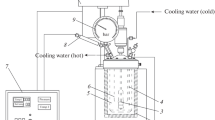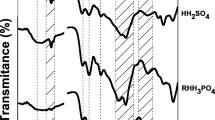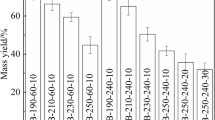Abstract
In this study, banana stalk was used as a feedstock to produce hydrochar by hydrothermal carbonization (HTC). The effect of varying carbonization temperature (160 to 200 °C), varying reaction time (1 to 3 h) on yield, and higher heating value (HHV) of hydrochar was examined. With increasing temperature and reaction time, the hydrochar yield varied from 57.8 to 75.3%, whereas HHV varied from 18.1 to 18.9 MJ/kg. The carbon content, energy density, and energy recovery of all of the hydrochars were improved after conversion. The decrease of the O/C and H/C values was in agreement with the increasing coalification of hydrochars with increasing the severity of HTC conditions. The surface characteristics and thermal degradation properties of hydrochars were also assessed by Fourier transform infrared spectroscopy (FTIR) and thermogravimetric analysis (TGA). The low ash and sulfur content after the HTC process indicates that banana stalk hydrochar can be a potential raw material for energy production.



Similar content being viewed by others
References
Mohapatra D, Mishra S, Sutar N (2010) Banana and its by-product utilization: an overview. J Sci Ind Res 69:323–329
Kumar KPS, Bhowmik D, Duraivel S, Umadevi M (2012) Traditional and medicinal uses of banana. J Pharmacogn Phytochem 1(3):51–63
FAO (2018) Banana facts and figures. http://www.fao.org/economic/est/est-commodities/bananas/bananafacts/en/#.WrqtudRubIX (visted on 27/03/2018)
BBS (2014) Report on the productivity survey of banana crop 2013. Productivity assessment survey of different agricultural crops programme, Bangladesh bureau of statistics. http://203.112.218.65:8008/PageWebMenuContent.aspx?MenuKey=241 (visited on 26/03/2018)
Mohiuddin AKM, Saha MK, Hossian MS Ferdoushi A (2014) Usefulness of banana (Musa paradisiaca) wastes in manufacturing of bio-products: a review. Agriculturists 12(1):148–158
Tock JY, Lai CL, Lee KT, Tan KT, Bhatia S (2010) Banana biomass as potential renewable energy resource: a Malaysian case study. Renew Sust Energ Rev 14(2):798–805
Abdullah N, Sulaiman F, Miskam MA, Taib RM (2014) Characterization of banana (Musa spp.) pseudo-stem and fruit-bunch-stem as a potential renewable energy resource. Int J Biol Vet Agric Food Eng 8(8):712
Gabhane J, William SP, Gadhe A, Rath R, Vaidya AN, Wate S (2014) Pretreatment of banana agricultural waste for bio-ethanol production: individual and interactive effects of acid and alkali pretreatments with autoclaving, microwave heating and ultrasonication. Waste Manag 34(2):498–503
Fernandes ERK, Marangoni C, Souza O, Sellin N (2013) Thermochemical characterization of banana leaves as a potential energy source. Energy Convers Manag 75:603–608
Nathoa C, Sirisukpoca U, Pisutpaisal N (2014) Production of hydrogen and methane from banana peel by two phase anaerobic fermentation. Energy Procedia 50:702–710
Al-Hamamre Z, Saidan M, Hararah M, Rawajfeh K, Alkhasawneh HE, Al-Shannag M (2017) Wastes and biomass materials as sustainable-renewable energy resources for Jordan. Renew Sust Energ Rev 67:295–314
Hau JL, Ray R, Thorpe RB, Azapagic A (2008) A thermodynamic model of the outputs of gasification of solid waste. Int J Chem React Eng 6(1):A35
Yao Z, Ma X, Wu Z, Yao T (2017) TGA–FTIR analysis of co-pyrolysis characteristics of hydrochar and paper sludge. J Anal Appl Pyrolysis 123:40–48
Gumisiriza R, Hawumba JF, Okure M, Hensel O (2017) Biomass waste-to-energy valorisation technologies: a review case for banana processing in Uganda. Biotechnol Biofuels 10(1):11
Kambo HS, Dutta A (2015) A comparative review of biochar and hydrochar in terms of production, physico-chemical properties and applications. Renew Sust Energ Rev 45:359–378
Yao Z, Ma X (2018) Effects of hydrothermal treatment on the pyrolysis behavior of Chinese fan palm. Bioresour Technol 247:504–512
Chen X, Lin Q, He R, Zhao X, Li G (2017) Hydrochar production from watermelon peel by hydrothermal carbonization. Bioresour Technol 241:236–243
Chen X, Ma X, Peng X, Lin Y, Yao Z (2018) Conversion of sweet potato waste to solid fuel via hydrothermal carbonization. Bioresour Technol 249:900–907
Islam MA, Asif M, Hameed BH (2015) Pyrolysis kinetics of raw and hydrothermally carbonized Karanj (Pongamiapinnata) fruit hulls via thermogravimetric analysis. Bioresour Technol 179:227–233
Reza MT, Lynam JG, Uddin MH, Coronella CJ (2013) Hydrothermal carbonization: fate of inorganics. Biomass Bioenergy 49:86–94
Volpe M, Fiori L, Volpe R, Messineo A (2016) Upgrading of olive tree trimmings residue as biofuel by hydrothermal carbonization and torrefaction: a comparative study. Chem Eng Trans 50:13–18
Nizamuddin S, Baloch HA, Griffin GJ, Mubarak NM, Bhutto AW, Abro R, Mazari SA, Ali BS (2017) An overview of effect of process parameters on hydrothermal carbonization of biomass. Renew Sust Energ Rev 73:1289–1299
Lucian M, Volpe M, Gao L, Piro G, Goldfarb JL, Fiori L (2018) Impact of hydrothermal carbonization conditions on the formation of hydrochars and secondary chars from the organic fraction of municipal solid waste. Fuel 233:257–268
Park KY, Lee K, Kim D (2018) Characterized hydrochar of algal biomass for producing solid fuel through hydrothermal carbonization. Bioresour Technol 258:119–124
Mäkelä M, Benavente V, Fullana A (2015) Hydrothermal carbonization of lignocellulosic biomass: effect of process conditions on hydrochar properties. Appl Energy 155:576–584
Nakason K, Panyapinyopol B, Kanokkantapong V, Viriya-empikul N, Kraithong W, Pavasant P (2018) Characteristics of hydrochar and hydrothermal liquid products from hydrothermal carbonization of corncob. Biomass Conv Bioref 8(1):199–210
Smith AM, Whittaker C, Shield I, Ross AB (2018) The potential for production of high quality bio-coal from early harvested Miscanthus by hydrothermal carbonisation. Fuel 220:546–557
Volpe M, Wüst D, Merzari F, Lucian M, Andreottola G, Kruse A, Fiori L (2018) One stage olive mill waste streams valorisation via hydrothermal carbonisation. Waste Manag 80:224–234
Mäkelä M, Kwong CW, Broström M, Yoshikawa K (2017) Hydrothermal treatment of grape marc for solid fuel applications. Energy Convers Manag 145:371–377
Luz FC, Volpe M, Fiori L, Manni A, Cordiner S, Mulone V, Rocco V (2018) Spent coffee enhanced biomethane potential via an integrated hydrothermal carbonization-anaerobic digestion process. Bioresour Technol 256:102–109
Adebisi GA, Chowdhury ZZ, Hamid SBA, Ali E (2016) Hydrothermally treated banana empty fruit bunch fiber activated carbon for Pb (II) and Zn (II) removal. BioResources 11(4):9686–9709
Nhuchhen DR, Salam PA (2012) Estimation of higher heating value of biomass from proximate analysis: a new approach. Fuel 99:55–63
Li S, Xu S, Liu S, Yang C, Lu Q (2004) Fast pyrolysis of biomass in free-fall reactor for hydrogen-rich gas. Fuel Process Technol 85:1201–1211
Lynam JG, Coronella CJ, Yan W, Reza MT, Vasquez VR (2011) Acetic acid and lithium chloride effects on hydrothermal carbonization of lignocellulosic biomass. Bioresour Technol 102:6192–6199
Lu XW, Pellechia PJ, Flora JRV, Berge ND (2013) Influence of reaction time and temperature on product formation and characteristics associated with the hydrothermal carbonization of cellulose. Bioresour Technol 138:180–190
Hitzl M, Corma A, Pomares F, Renz M (2015) The hydrothermal carbonization (HTC) plant as a decentral biorefinery for wet biomass. Catal Today 257:154–159
Funke A, Ziegler F (2010) Hydrothermal carbonization of biomass: a summary and discussion of chemical mechanisms for process engineering. Biofuels Bioprod Biorefin 4:160–177
Kannan S, Gariepy Y, Raghavan GV (2018) Optimization of the conventional hydrothermal carbonization to produce hydrochar from fish waste. Biomass Conv Bioref 8(3):563–576
McGaughy K, Reza MT (2018) Hydrothermal carbonization of food waste: simplified process simulation model based on experimental results. Biomass Conv Bioref 8(2):283–292
Nizamuddin S, Mubarak NM, Tiripathi M, Jayakumar NS, Sahu JN, Ganesan P (2016) Chemical, dielectric and structural characterization of optimized hydrochar produced from hydrothermal carbonization of palm shell. Fuel 163:88–97
Zhang D, Wang F, Shen X, Yi W, Li Z, Li Y, Tian C (2018) Comparison study on fuel properties of hydrochars produced from corn stalk and corn stalk digestate. Energy 165:527–536
Nakason K, Panyapinyopol B, Kanokkantapong V, Viriya-empikul N, Kraithong W, Pavasant P (2018) Characteristics of hydrochar and liquid fraction from hydrothermal carbonization of cassava rhizome. J Energy Inst 91(2):184–193
Yang HP, Yan R, Chen HP, Lee DH, Zheng CG (2007) Characteristics of hemicelluloses, cellulose and lignin pyrolysis. Fuel 86:1781–1788
Ahmad MS, Mehmood MA, Al Ayed OS, Ye G, Luo H, Ibrahim M, Rashid U, Nehdi IA, Qadir G (2017) Kinetic analyses and pyrolytic behavior of Para grass (Urochloa mutica) for its bioenergy potential. Bioresour Technol 224:708–713
Mäkelä M, Volpe M, Volpe R, Fiori L, Dahl O (2018) Spatially resolved spectral determination of polysaccharides in hydrothermally carbonized biomass. Green Chem 20(5):1114–1120
Zhang D, Wang F, Zhang A, Yi W, Li Z, Shen X (2019 Mar 1) Effect of pretreatment on chemical characteristic and thermal degradation behavior of corn stalk digestate: comparison of dry and wet torrefaction. Bioresour Technol 275:239–246
Yuan J-H, Xu R-K, Zhang H (2011) The forms of alkalis in the biochar produced from crop residues at different temperatures. Bioresour Technol 102:3488–3497
Funding
The authors gratefully acknowledge the Bangladesh Bureau of Educational Information & Statistics (BANBEIS), Ministry of Education, Government of Bangladesh, under advanced research in education scheme (No.37.20.0000.004.003.020.2016) for financial support.
Author information
Authors and Affiliations
Corresponding author
Additional information
Publisher’s note
Springer Nature remains neutral with regard to jurisdictional claims in published maps and institutional affiliations.
Rights and permissions
About this article
Cite this article
Islam, M.A., Akber, M.A., Limon, S.H. et al. Characterization of solid biofuel produced from banana stalk via hydrothermal carbonization. Biomass Conv. Bioref. 9, 651–658 (2019). https://doi.org/10.1007/s13399-019-00405-5
Received:
Revised:
Accepted:
Published:
Issue Date:
DOI: https://doi.org/10.1007/s13399-019-00405-5




